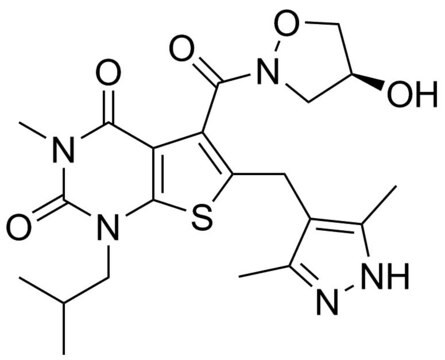α-Cyano-4-hydroxycinnamic acid (α-CCA, α-CHCA, α-Cyano, 4-HCCA, ACCA) is soluble in methanol (up to 50 mg/ml). It is also soluble at 10 mg/ml using 50% acetonitrile in 0.05% TFA for MALDI-MS. The acetonitrile concentration can be adjusted for individual preferences.For biological applications, it has been solubilized at 100 mM in DMSO or 50 mM in ethanol.
Wichtige Dokumente
C2020
α-Cyano-4-hydroxyzimtsäure
≥98% (TLC), powder, monocarboxylic acid transport inhibitor
Synonym(e):
α-CCA, α-CHCA, α-Cyano, 4-HCCA, ACCA
Größe auswählen
Größe auswählen
About This Item
Empfohlene Produkte
Produktbezeichnung
α-Cyano-4-hydroxyzimtsäure, ≥98% (TLC), powder
Qualitätsniveau
Assay
≥98% (TLC)
Form
powder
Farbe
yellow
mp (Schmelzpunkt)
245-250 °C (lit.)
Löslichkeit
H2O: slightly soluble
methanol: water: soluble
polar organic solvents: soluble
Lagertemp.
2-8°C
SMILES String
OC(=O)\C(=C\c1ccc(O)cc1)C#N
InChI
1S/C10H7NO3/c11-6-8(10(13)14)5-7-1-3-9(12)4-2-7/h1-5,12H,(H,13,14)/b8-5+
InChIKey
AFVLVVWMAFSXCK-VMPITWQZSA-N
Suchen Sie nach ähnlichen Produkten? Aufrufen Leitfaden zum Produktvergleich
Anwendung
Signalwort
Warning
H-Sätze
Gefahreneinstufungen
Skin Sens. 1B
Lagerklassenschlüssel
11 - Combustible Solids
WGK
WGK 3
Flammpunkt (°F)
Not applicable
Flammpunkt (°C)
Not applicable
Persönliche Schutzausrüstung
dust mask type N95 (US), Eyeshields, Gloves
Hier finden Sie alle aktuellen Versionen:
Besitzen Sie dieses Produkt bereits?
In der Dokumentenbibliothek finden Sie die Dokumentation zu den Produkten, die Sie kürzlich erworben haben.
Kunden haben sich ebenfalls angesehen
Artikel
Warburg effect enhances glucose to lactate conversion in tumor cells, regardless of oxygen levels; impacting cancer metabolism since 1924.
DISCOVER Bioactive Small Molecules for Nitric Oxide & Cell Stress Research
Verwandter Inhalt
ZipTip® micro-SPE pipette tips are used as a single-step desalting, concentration, and purification tool for complex samples before mass spec analyses.
-
What can be used for solublization of α-Cyano-4-hydroxycinnamic acid?
1 answer-
Helpful?
-
-
What is the Department of Transportation shipping information for this product?
1 answer-
Transportation information can be found in Section 14 of the product's (M)SDS.To access the shipping information for this material, use the link on the product detail page for the product.
Helpful?
-
Active Filters
Unser Team von Wissenschaftlern verfügt über Erfahrung in allen Forschungsbereichen einschließlich Life Science, Materialwissenschaften, chemischer Synthese, Chromatographie, Analytik und vielen mehr..
Setzen Sie sich mit dem technischen Dienst in Verbindung.











